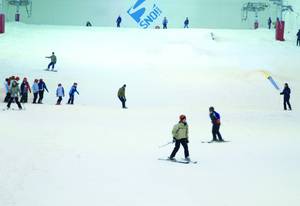Indoor Snow
Interview with
Yes, it is the season that many of us decide to go skiing to various resorts around the world. But this week we're at a place you can ski all year round; it's in the UK and also indoors! It is the Milton Keynes SnoZone, part of the Xscape Leisure complex in Buckinghamshire. There are 3 snow slopes, two which are up to 173 metres long and 20 metres wide. The best bit is that all of these slopes are actually covered with real snow. So what does it take to create the snow that's in here and fill basically a big dome like this with tonnes and tonnes of snow? Meera Senthilingam spoke with Richard Shears, who's the facilities manager at Snozone...
Richard - The temperature here at the moment, Meera, is -2, -3 degrees. Up above us are some large radiators. Within the radiators there are six large fans. These large fans blow air across a radiator and the radiator is cooled down to -16 degrees with an antifreeze mixture inside it. When we're running at full capacity with 100% fans we'll it down to probably -6 degrees. That's the temperature that we make the snow.
Meera - Can you describe the actual structure here of the slope?
Richard - Underneath the snow is a large concrete slab stretch from the base of the slope, right up to the top. The concrete slab is covered with an insulating material and on top of the insulating material is lines of 20mm pipes. These 20mm pipes contain the antifreeze mixture which is cooled down to -16 degrees. Each time we run water over the pipes it freezes and gives us a depth of ice down to 30-40mm thick of ice. We have an ice layer under the snow.
Meera - To find out how the snow's actually made we're going to head up to the snow bar which is on the second floor and looks out over the snow slopes so we can actually see the sprayers that the snow is created form. Let's head up there now because I can't feel my fingers at the moment!
Now Richard, you create up to 1500 tonnes of snow here, all with these sprayers that seem to be located at different positions around the room. How do these actually go about creating the snow?
Richard - The snow's created by using high-pressure water and air which runs through what we call a snow gun. The water and the air are broken up into fine particles and then blown out at high pressure into the atmosphere of the ski box. When the mixture hits the atmosphere it freezes into a fine mist which lands onto the ground, which forms real snow.
Meera - What other conditions need to be maintained to get the maximum snow created here?
 Richard - During the night we can drop the temperature of the ski box to -6/-7 degrees. Providing the humidity is right within the box we can make the snow that temperature. Obviously the higher you can drop the snow from the snow guns the longer it has to form, the better the snow can be made.
Richard - During the night we can drop the temperature of the ski box to -6/-7 degrees. Providing the humidity is right within the box we can make the snow that temperature. Obviously the higher you can drop the snow from the snow guns the longer it has to form, the better the snow can be made.
Meera - How does this compare to the snow we get outside? Is it the same?
Richard - The structure of the snow is a little bit different where you have nice snowflakes outside and they'll probably fall 30,000 feet. We're falling from 40-50 feet. The ice crystal doesn't have that time to actually form. Outside every snowflake that your get is different. If you put them under a microscope you'll see the shape is different. In the snow we get here, because it's a controlled environment it's an ice crystal that comes out but they're all formed in the same structure.
Meera - What do the actual crystals look like? Are they quite spherical then?
Richard - Yes, they're round. If you put them under a microscope they're all uniform. They're all round.
Meera - We've been talking so much about snow and I can see all these skiers in front of me that I really need to go and try it out for myself....
- Previous Making your own Aspirin
- Next Bubbles go Straight to your Head










Comments
Add a comment